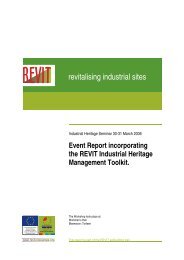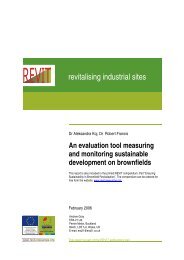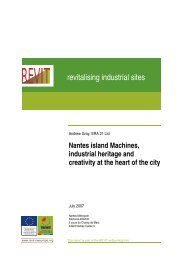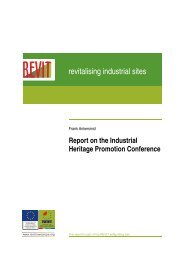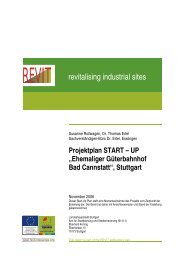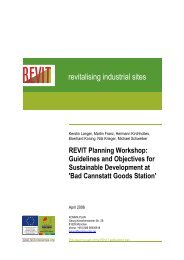REVIT Heritage Report.pdf
REVIT Heritage Report.pdf
REVIT Heritage Report.pdf
Create successful ePaper yourself
Turn your PDF publications into a flip-book with our unique Google optimized e-Paper software.
Torfaen County Borough Council<br />
<strong>REVIT</strong>: A Review of the Conservation of Industrial <strong>Heritage</strong> Assets on Brownfield Sites<br />
5 Conclusions<br />
5.1 Introduction<br />
5.1.1 Industrial heritage is increasingly recognised as a valuable and finite resource<br />
which forms part of our common European cultural heritage. Large parts of<br />
this legacy have already been lost and so it is vital to preserve the remaining<br />
sustainable elements of our industrial buildings, monuments and<br />
archaeological sites for future generations. The regeneration schemes which<br />
this report has examined generally, though not exclusively, involve a range of<br />
standing industrial buildings and structures, although sub-surface<br />
archaeological remains can be just as important to interpreting a site.<br />
5.1.2 In this respect a central principle for providing the long-term conservation of<br />
historic buildings is that the most sympathetic form of re-use is nearly always<br />
the use closest to its existing or original function. However, the size and<br />
design of a building or structure, the level of statutory protection, the<br />
geographic location, the local economic requirements and community needs<br />
will always be important constraints in the regeneration of industrial sites.<br />
5.1.3 Secondly finding a sustainable economic function is frequently the best way of<br />
ensuring the future preservation of a building. The loss of a sustainable<br />
function can make historic buildings vulnerable to demolition, neglect or<br />
vandalism. One solution to the problem of decline is to pre-empt that cycle of<br />
decline, if possible, and plan for re-use as buildings become vacant.<br />
5.1.4 However, there must always be a balance between conserving the industrial<br />
heritage and new development. Brownfield sites are often archaeologically<br />
sensitive and require a proper assessment of sub-surface features in advance<br />
of design proposals. In terms of historic standing structures and sub-surface<br />
archaeology, early consultation is recommended in order that any constraints<br />
can be avoided in the design process and where this is not possible, any<br />
archaeological sites are recorded in advance, avoiding time and programming<br />
difficulties.<br />
5.1.5 Sustainable tourism can also improve the balance between more or less<br />
affluent areas and contribute to the safeguarding of cultural heritage and the<br />
improvement the quality of life and education. Tourism is a key component in<br />
the safeguarding of the cultural heritage, functioning landscapes and the<br />
maintenance of biodiversity.<br />
5.2 European Perspectives<br />
5.2.1 There are many common themes to these European case studies. These<br />
include:<br />
• Transportation features: railways, canals; and<br />
• Waterways: rivers, docks, harbours, canals<br />
5.2.2 During the 20 th century many historic dockyards, canals and waterways were<br />
abandoned but, where they survive, these represent an important resource<br />
which provides ecological habitats and in many cases can still supply<br />
sustainable tourism or a method of transporting bulky materials. In addition,<br />
most waterfronts have a distinctive historic character which, after regeneration,<br />
0014021/JM/001 40




